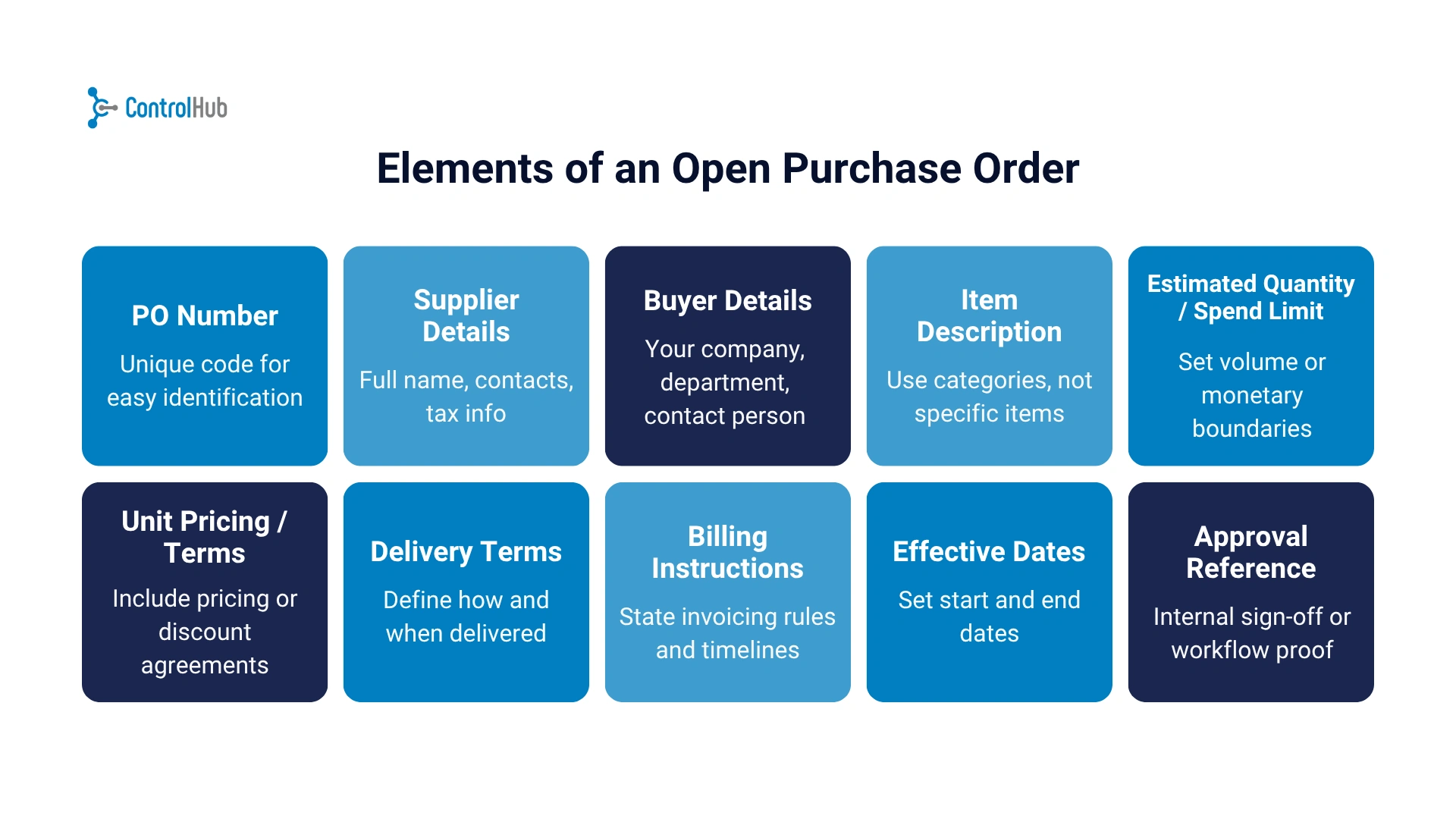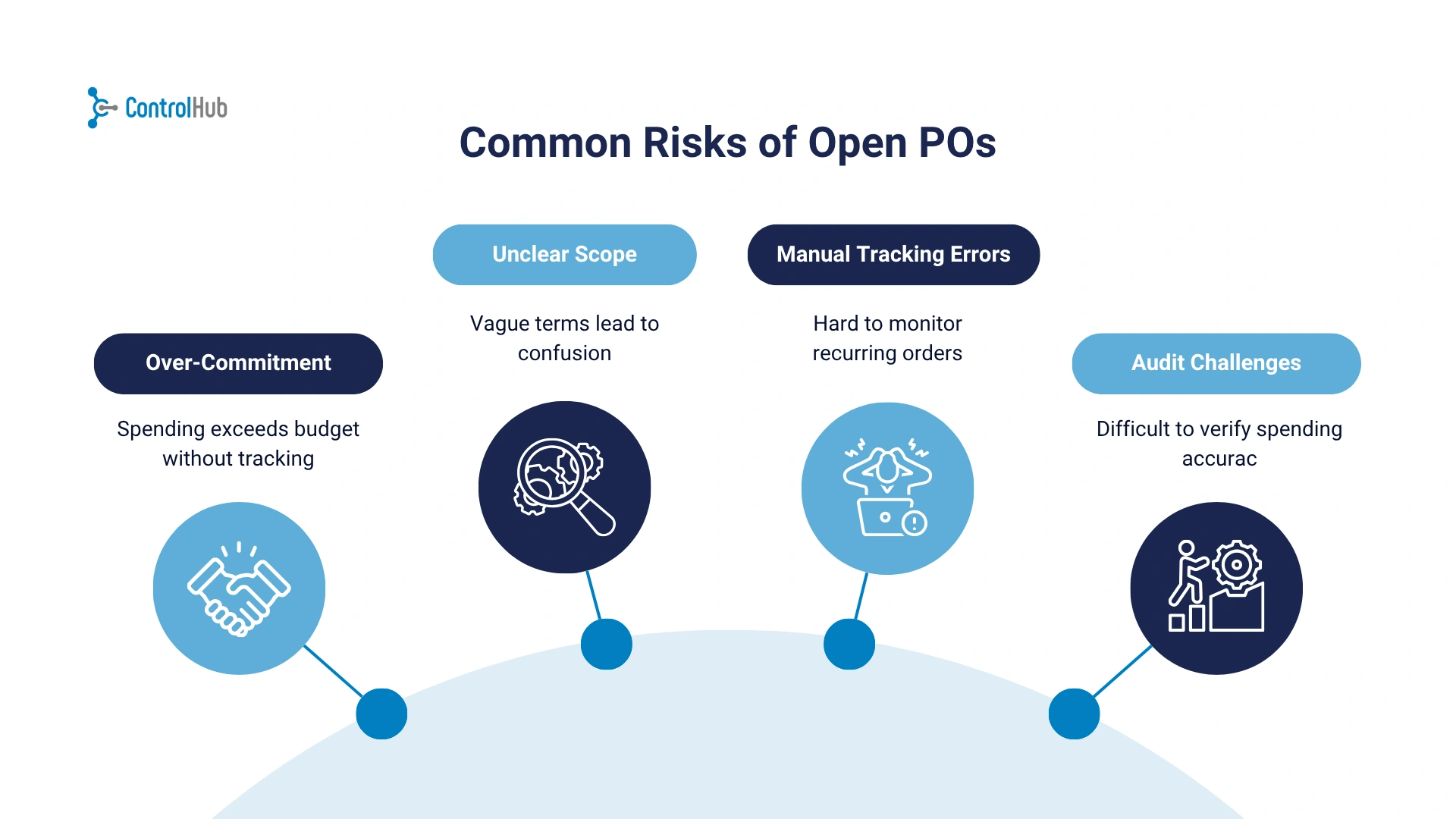Free Supplier Risk Scorecard Download
Download our free supplier risk scorecard here!
Download the free tool!AI Summarize:
When a business wants to purchase from a supplier, there's a fact that can't be ignored.
The process isn't as straightforward as it should be.
You've to deal with things like sourcing, making sure there's an alignment between the offer and your demands, negotiating for the best deals…
And well, you know how the rest goes.
So here's a question: Do you really need to go over all those procurement steps when you buy the same thing from the same supplier?
Not really
That’s why Open Purchase Orders are for
Useful for saving time, you don't want to manage Open POs blindly
What are Open Purchase Orders?
Perfect for recurrent purchases, an Open PO, also known as a standing PO, is a purchase order you can use to acquire goods from a supplier over a period of time, without having to create a new PO for every purchase.
If you know what you are buying from whom and in what quantity, Open POs can work pretty well as a pre-approved contract.
How Open PO works
Let's say that you work in the manufacturing industry and that you know what sort of raw materials you are going to need over the next quarter. You've done your job and found a reliable supplier to work with, have already made some purchases, and there haven't been any issues so far. Instead of wasting time creating more and more POs every time you buy something from them, you decide to use an open purchase order with a budget of…$5000. Each time you place an order, the amount is deducted from the PO until the total limit is reached.
When to use open purchase orders?
Open purchase orders might seem like a great alternative to traditional POs, but they are far from being a one-size-fits-all tool.
Ideally, Open POs work best when:
- Your company has been working with a supplier or group of suppliers for a considerable period, and you have full confidence in their reliability.
- Following the above scenario, you realize it's time to simplify purchasing. Maybe you need to move faster and focus on something else.
Elements of an Open Purchase Order
- PO number: Just like with any other PO, you must use a code or number so it's easy to identify the document for both sides, your company and the supplier.
- Supplier details: Include the supplier’s full legal name, contact details, and any relevant tax or account numbers. This guarantees the PO is directed to the right party and simplifies your communications.
- Buyer Details: Add your company’s name, department, and main point of contact.
- Item description: This is where things start to look different. Unlike regular purchase orders, open POs don't go into details for the items acquired. It's more likely to use categories.
- Estimated quantity and spend limit: It might be called an open purchase order in theory but it's not completely open. You need to establish some sort of limits, it could be in terms of money or expected order volume.
- Unit pricing or terms: Include agreed-upon pricing or any discount structure in place. If prices may fluctuate, note that too,transparency up front helps prevent disputes later.
- Delivery and fulfillment terms: Be completely clear on how and when the goods are expected to be delivered
- Billing instructions: Invoices are a fundamental part of any purchasing process. Do you have any specific policies about it? Time to mention them.
- Effective Dates: Duration the PO is expected to last. It won't be permanent after all.
- Approval Reference: What's your internal authorization workflow like?
Free Supplier Risk Scorecard Download
Download our free supplier risk scorecard here!
Download the free tool!Benefits of Open Purchase Orders
Simplified procurement operations for certain purchases
Open purchase orders are a great choice, as long as the context is the right one. If you are constantly buying office supplies, the same type of materials or paying for recurrent subscriptions, there's no need to deal with a different PO for every purchase. You can agree on the terms and set an open purchase order to cover all your related purchases.
That certainly saves you from the stress of following longer procurement procedures.
Faster processing
And speaking of stressful procedures…
If you were to choose a procurement process as the cause of most delays, wouldn't approvals be in the list?
Because an open PO is pre-approved, you can bypass the full review and approval cycle for each individual order.
The result?
Things move faster, giving you the products your business needs with fewer delays.
Positive impact on supplier relationships
Suppliers appreciate open POs just as much as you do. They provide predictability, which helps suppliers manage inventory, plan deliveries, and prioritize your orders. Plus, by showing commitment to regular business, you may gain access to better pricing, faster service, or even exclusive deals. A solid open PO can lay the groundwork for a stronger, more collaborative relationship over time.
Free Supplier Risk Scorecard Download
Download our free supplier risk scorecard here!
Download the free tool!Common Risks of Open POs
Okay so are open purchase orders perfect?
No
They are useful, that's for sure but if you don't manage them correctly those open PO might quickly become a source of confusion and financial issues.
For example…
Risk of over-commitment or budget overruns
The main problem of open purchase orders?
Comes from what makes them great.
If you create an open PO just to forget about its limits and never check how much you are spending or how much money is left, you could start purchasing more than planned
Without regular check-ins, you could accidentally go over budget before you even realize it.
Lack of clarity in scope
Because open POs usually cover broader categories of goods or services, vague descriptions can lead to misunderstandings. For example, “IT equipment” could mean anything from keyboards to high-end servers. If the scope isn’t clearly defined upfront, suppliers might deliver items you didn’t intend to order. And if you want to return them?
Good luck with that
After all, you kind of settled for an open agreement, right?
Manual tracking errors
Keeping an eye on regular PO manually is already messy.
Doing it for open PO?
Confusing as heck
You can easily lose sight of what's been ordered or when it was delivered, even more if your company is growing and moving fast.
This can lead to payment delays, duplicate orders, or missing items in inventory.
Difficulty in auditing open PO balances
During financial reviews or audits, open POs can be tricky to account for,especially if usage logs are inconsistent or approvals aren’t properly documented. It’s important you keep clear records of each drawdown against the PO, so your finance teams can verify that spending aligns with the original agreement.
Best Practices to Manage Open PO
- Set a clear dollar limit or quantity cap on every open PO
- Use broad but specific descriptions (e.g., “monthly janitorial supplies,” not just “supplies”)
- Always include a start and end date, you don’t want leave it open forever
- Lock in pricing or at least document agreed terms
- Set reminders to review usage halfway through the PO’s duration
- Track each purchase against the PO in real time, and yes, automated tools help a lot here.
- Don’t skip approvals, just streamline them
- Communicate limits with your supplier so they don’t over-ship
- Reconcile regularly with accounting or finance to avoid surprise overruns
- Close or renew open POs once they expire,don’t let them go stale
- Store documentation somewhere your team can actually find it
- Review supplier performance at the end of each PO period
The Lesson
Open purchase orders might not be flashy, but they’re one of the most practical tools you can use to simplify repeat purchasing. When set up correctly, they save time, reduce admin work, and give you better visibility into your spend,all while making life easier for your suppliers too.
The key, as we've learnt, starts getting the structure right from the beginning: clear scope, spend limits, and good tracking. Combine that with the right tools and a few simple best practices, and you’ll avoid common pitfalls like budget overruns or scope confusion.
If your team is handling the same types of purchases again and again, it might be time to give open POs a serious look. Start small, keep it clean, and adjust as you go.
Free Supplier Risk Scorecard Download
Download our free supplier risk scorecard here!
Download the free tool!Free Supplier Risk Scorecard Download
Download our free supplier risk scorecard here!
Download the free tool!Key Takeaways
Open purchase orders are ideal for recurring purchases with consistent vendors.
They help reduce repetitive paperwork, speed up processing, and improve spend visibility.
A well-structured open PO should include clear descriptions, spend limits, pricing terms, and effective dates.
Common risks include vague scope, overspending, and manual tracking issues—but these can be managed with the right processes.
Best practices include setting usage caps, reviewing regularly, automating tracking, and closing or renewing POs on time.
When used properly, open POs can simplify your procurement workflow and build stronger supplier relationships.
%20(1).avif)




.webp)












.png)


